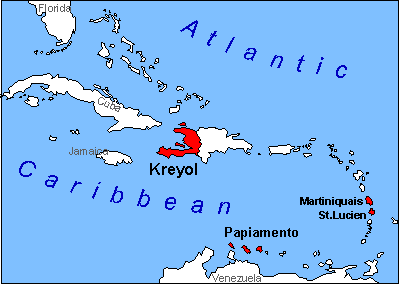Introduction
A French creole, or French-based creole language, is a creole language based on the French language, more specifically on a 17th century koiné French extent in Paris, the French atlantic harbors, and the nascent French colonies. Descendants of the non-creole colonial koiné are still spoken in Canada (mostly in Québec), the Prairies, Louisiana, Saint-Barthélemy (leeward portion of the island) and as isolates in other parts of the Americas.
Geographic distribution

Of Romance creoles used today, French creoles are most widespread. In Haiti, which was settled in the mid-17th century, there are some six million creole speakers, of whom only about 10 percent know French, and French creole is an official language, together with French. The Lesser Antilles (Martinique, Guadeloupe, Dominica, Saint Lucia, Saint Kitts and Nevis, etc.) were colonized in 1635, and many of the islands still use French creoles, even when change of ownership led to the imposition of English as the official language.
French creoles also are used in French Guiana and, though dying out, in the U.S. state of Louisiana; Haitian immigrants also account for a large number of the French creole speakers in the United States. In all, more than seven million speakers use French creoles in the Americas.
On islands of the Indian Ocean, too, French creoles are spoken; in Mauritius, which was owned by France from 1715 to 1810, French creole (Morisyen) is spoken as a first language by some 600,000 and retains its hold as a lingua franca, even though English is the official language and though a large part of the population uses an Indo-Aryan or Dravidian language at home. In the Seychelles, which were owned by France from 1768 until 1814, and in Runion (originally L'île Bourbon), where French is still the official language, French creoles are still in widespread use (in the Seychelles the language is called Seselwa). Some French-creole speakers claim that creoles from other far-off regions are easily intelligible to them. Others contest this, however, pointing out that the creole used by educated speakers is often heavily larded with standard French on all but very informal occasions. Certainly, the linguist can easily discern similarities, especially in grammatical structure, that make the various French creoles seem more like each other than like standard French.
Classification
- Caribbean
- Guadeloupean Creole French
- Guianese Creole French
- Haitian Creole French
- Amapá Creole / Karipúna Creole French
- Saint Lucian Creole French
- San Miguel Creole French
- Martinican Creole
- North America
- Indian Ocean
- Morisyen
- Réunion Creole French
- Seselwa Creole French
- Pacific